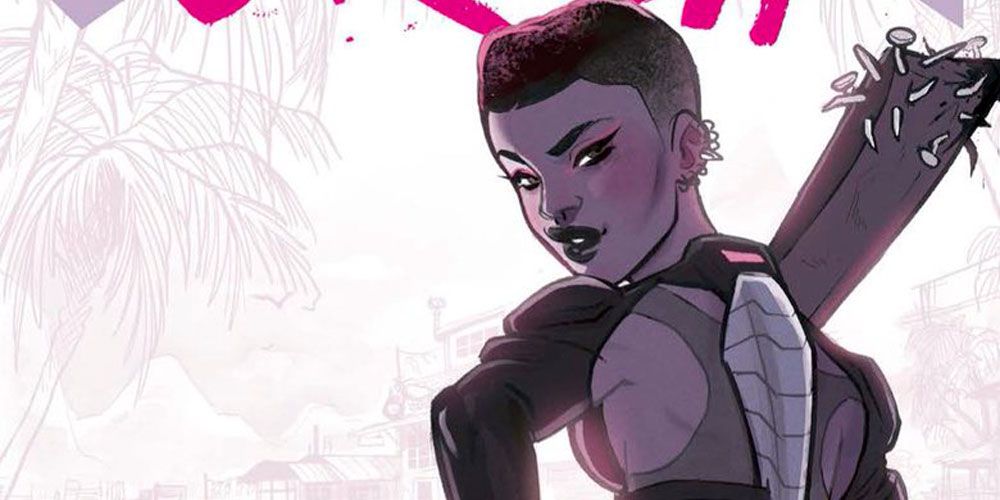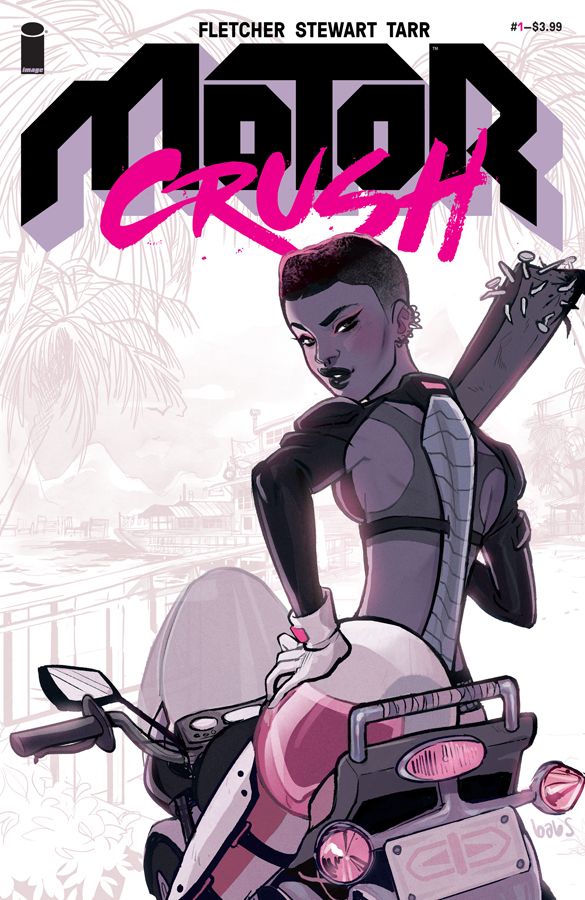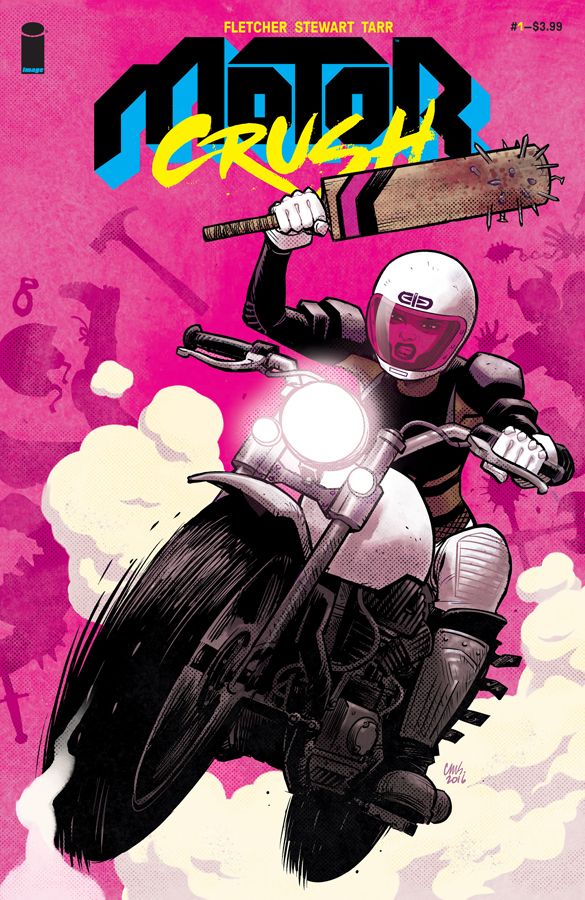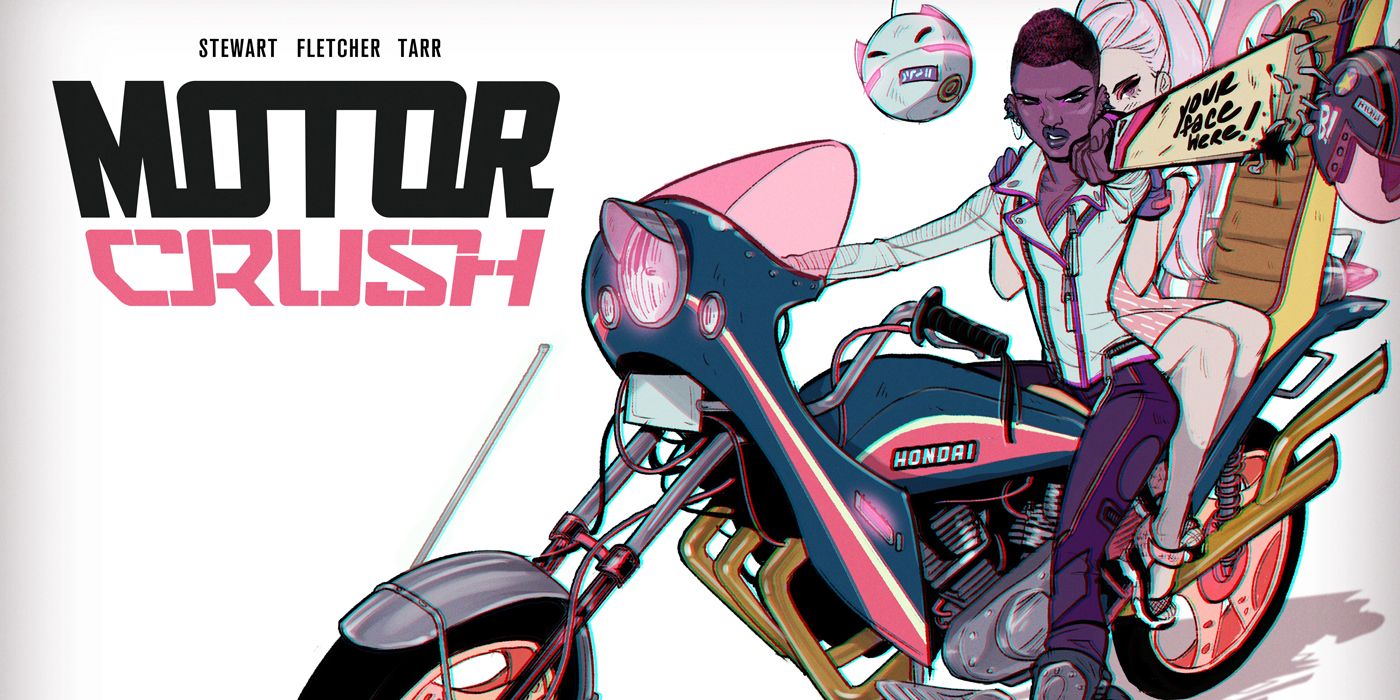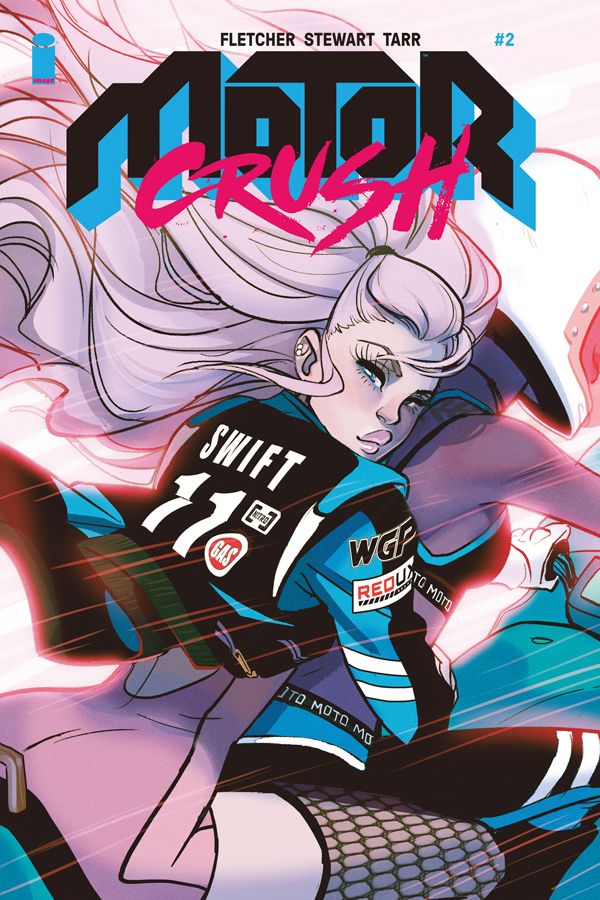In 2014, the trio of Babs Tarr, Brenden Fletcher and Cameron Stewart made a seismic impact on the comic book industry with their reinvention of DC Comics' "Batgirl." From the first promotional image released, fans were taken by youthful energy infused into the title character, from the character's redesign -- staying close to the classic look while adding modern touches like yellow Doc Martens -- to broadening the world of Gotham City by introducing the hipster-heavy neighborhood of Burnside.
The team ended their run on "Batgirl" earlier this year, but quickly announced their next project together: "Motor Crush," a creator-owned series published by Image Comics, which made its anticipated debut this week. "Motor Crush" is set in a world not entirely dissimilar to the real one, but with noticeable sci-fi touches like an ever-present media (maybe not that far from reality) and a hot pink performance-enhancing drug called Crush. The main character is motocross star/street racer Domino Swift, a more morally ambiguous protagonist than Barbara Gordon.
CBR spoke with Fletcher, Stewart and Tarr to discuss moving from "Batgirl" to "Motor Crush," their perspectives on Domino's strengths as lead character, the influence of real-world street bike culture, bringing speed to a static medium and the contributions of designer Tom Muller and letterer Aditya Bidikar.
CBR: There's a lot of the "Batgirl" energy in "Motor Crush" thus far, but obviously it's a different book and a different statement from this team. For the three of you, how different does it feel working on "Motor Crush" than it did on "Batgirl"? How has this collaboration evolved from where it started back in 2014?
Brenden Fletcher: You’re gonna hate this answer, Albert, but so much of our process is exactly what it was in the past and so much is completely different! I’m still working directly with Cameron on story, just as before, and Cameron is providing Babs page layouts, just as in "Batgirl," but outside of that everything seems a lot more organic.
Babs has been working with us on story and Cameron is in on some of the more detailed page work, while I’ve been getting my hands dirty in areas of this new business outside of the creative. It’s a weird, wild time for all of us!
Cameron Stewart: We’re very lucky to have been able to build a strong team for the series. Aditya Bidikar and Tom Muller are working closely with us on lettering and design, respectively -- much closer than we were ever allowed to work with our fellow creatives in those positions on previous projects.
We’re also very fortunate to be working with Jeanine Schaefer, our Editor-Supreme who keeps everything on track, from story to schedule.
Babs Tarr: Continuing with Brenden and Cameron was a no-brainer. I love working with them! It's been a treat to have Tom and Aditya to the team. They are beyond talented and put up with my crazy!
This process on "Motor Crush" is very exciting for me because I have more confidence and control than on "Batgirl." "Batgirl" was my first comic ever and I was so new to the process and the industry I was kind of shy. Now on "Motor Crush," I feel like I got my sea legs a little bit so I know more of what I am doing and with Image having so much creative freedom! I can't tell you how much I've enjoyed making a comic book look exactly the way I want it to look (if not better thanks to my amazing collaborators)! It's like a huge weight off my shoulders!! Coming from my illustration background where I get to control my work from start to finish -- it feels incredible not to have to settle for less.
Content-wise, what were some of the main things you were looking to do with "Motor Crush" -- thematically, structurally or otherwise -- that you didn't, or couldn't, do in "Batgirl"?
Fletcher: We were really excited to be able to make long-term story plans and have the liberty to see them through. Seems a simple and obvious concept and some might say a necessary part of the writing process but when working in a shared universe we creators always have to be ready to change or kill story elements (or characters!) on a dime. Ultimately, we’re just really excited to have control of our story!
Let's talk about the main character, Domino Swift, who feels rather realized from the first issue (though clearly there's a lot more exploring of her to come). What appeals to the three of you about this character? What do you see in her that you don't see elsewhere in comics?
Fletcher: There’s a depth to Domino that we’re only suggesting in the first issue, but it’s something I’m excited to dig into in upcoming parts of our first chapter, aspects of heroic protagonists we rarely see in popular western comics. Without giving away too much, Domino starts her journey fighting against herself. As much as it’s fun to see Dom battling her way through bike gangs, the really satisfying part of our story is watching her overcome her own personal obstacles.
Stewart: Domino isn’t a superhero or even heroic in the conventional sense. She’s not trying to save the world or rescue innocents in peril. In fact, her goals are often far more self-serving. But she’s a lot like us -- she’s a fundamentally good person, pushed into unusual situations that will often cause her to make mistakes. It not only grounds her and makes her relatable but I think it makes her someone to root for.
Tarr: Maybe it’s a little cheesy but I see a lot of myself in Domino.
The world of "Motor Crush" is intriguing off the bat -- as you've stated in earlier interviews, certainly a different world than our own, but more recognizable than a more typical sci-fi landscape. How much of the fun of this book has been building this world, setting the rules and figuring out where to push it and where to keep things grounded?
Fletcher: So much of the fun of "Motor Crush" has been the world building! I think it’s evident if you look at our "Batgirl" run that we really enjoy placing our characters in new spaces. Creating the burough of Burnside -- adding to the near-century old landscape of Batman’s Gotham City -- was not only an honor but one of the most gratifying aspects of working on our "Batgirl" series.
In the case of of "Motor Crush," all bets are off. We get to create all the rules. In Domino Swift’s world, motorcycles rule everything. It changes the way people dress and act, the way society operates, the way cities are built. And we get to make up all the rules! If we want to rewrite the way gravity works in Nova Honda, we can do it! We have absolute freedom.
Speaking of motorcycles, I know that "Motor Crush" originally was inspired from an animated series idea of Brenden's, and obviously "Batgirl" has a history with motorcycles -- how interested were all three of you going into this series in street bike culture? And how much have you researched the real-world aspects of it?
Fletcher: I’m certainly inspired by street bike culture and what it has the potential to become in a world that’s governed by a different set of rules. It was Babs’ art that really rekindled that in me and influenced me to dust off that old pitch that we were eventually able to mold into "Motor Crush."
It's also striking just from the first issue how important, naturally, a sense of motion and speed is for a series like this, which is not necessarily the easiest thing to capture in this medium. How much of a challenge is that from a visual and storytelling standpoint?
Stewart: It’s always a challenge to depict any kind of motion, let alone at top speed, in static images. To be honest I use a lot of tricks from great manga ("Akira" and "Gunsmith Cats" are two of my perennial favorites when it comes to vehicular action) and try to create a flow through the page where actions set up in one panel will pay off in the next. It's also about creating a sense of urgency within the story also, so there's a driving force to the action.
Tarr: Inks wise I am looser! Trying to capture speed visually by "speeding up" my mark making with far quick confident lines! I am so in love with Cameron's layouts. I can't wait to dig into them when I get them in our shared Dropbox. They so clearly read speed and I just love drawing from them. To put it in a fun way, "I'm picking up what Cameron's putting down!" [Laughs]
Color-wise it’s a very tricky balancing act! You have to set the mood by the palette -- lay down the colors, figure out the lighting and consider what the reader needs to see first according to what going on in that particular panel and then adjust all the the above accordingly. It can get tricky when you're in the dark with headlights and that's not the thing you want to draw the eye to the most! It's hard but I love problem solving these kinds of things. It's like solving a puzzle and it's fun to see it all come together.
A major part of the identity of the first issue is the obvious care and attention given to the presentation -- certainly the caption and design work from Tom Muller. How important was shaping the overall aesthetic of "Motor Crush," and how much are you looking to keep pushing those elements as the series moves forward?
Fletcher: There were practical narrative reasons to include the devices we’d eventually call upon Tom to design. We wanted "Motor Crush" to feel like a familiar, plugged in near-future without pushing too far into the realm of starships and Death Stars. An ever-present media whose information and perpetual call-outs that play across panels seemed like a fun way to represent that. We were all familiar with Tom’s work and were super-excited when he agreed to jam with us on the in-world and book design of "Motor Crush."
The distinctive lettering by Aditya Bidikar also shapes the feel of issue #1 quite a bit. What made Bidikar the right choice for the series, and how do you see the lettering as informing the overall "feel" of the book?
Stewart: I was originally going to letter the book but found that my lettering style wasn't quite meshing with the looseness of Babs’ final artwork, so had my eye out for an alternative solution. I happened to be at the Mumbai Comic Con in India and met Aditya, who was a really charming guy and said he was really excited for "Motor Crush" just as a reader. He mentioned that he was available so I had a look at some of his work (he also letters a couple of other Image titles, including "Drifter") and felt like he’d be a great addition to the team. As soon as we saw his letters on Babs’ art we knew it was the right call.
"Motor Crush" #1 is on sale now. Issue #2 is scheduled for release on Jan. 11.

